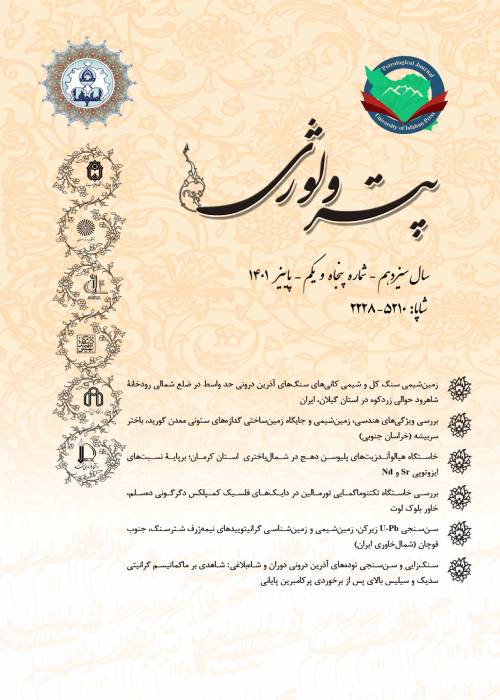Geochemistry, geochronology and tectonomagmaticsetting of igneous rocks in Ahmadabad Fe-Cu mineralization region, Semnan
Ahmadabad deposit is located 30 km northeast of the Semnan province, between the Alborz and the Central Iran sedimentary-tectonic structural zones. The Extensive magmatism of the Cenozoic age, with some irregularities, distributed throughout Iran (Emami et al., 1993). Magmatism in two dominant volcanic zones of Iran; the Urmia-Dokhtar trending northwest-southeast and the Alborz with east-west trend in the north of Iran started at the Cretaceous; while the most widespread magmatism occurred in the Eocene (Alavi, 1994). The youngest volcanism occurrence in the Alborz basin shows a close chemical relationship with continental arc rocks formed in the continental collision environment (Asiabanha et al., 2012). The exposed rocks in Ahmadabad district include the Cenozoic dacite, andesite, trachyandesite, basaltic andesite and basalt, associated with pyroclastic rocks comprises green to gray acidic tuffs with intercalations of shale, sandstone and conglomerate. Monzonite, monzodiorite and infrequent granodiorite and granite intruded the volcanic rocks sequence.
During field work, 54 samples were collected from the host rocks, alteration and mineralized zones. For petrographic study, 14 thin sections and 21 thin-polished sections were prepared and studied by ZEISS Axioplan2 research type polarized microscope at Kharazmi University, Tehran branch. After careful petrographic study, 41 samples of igneous units prepared at Kharazmi University for whole rock geochemical analysis and analyzed at Zarazma Co. using XRF and Iran Mineral Processing Research Center using ICP-MS methods. To complete mineralogical studies, 3 samples of mineralization zones were analyzed by XRD method. After preparation and separation of zircon from selected samples at Kharazmi University of Tehran, zircon of monzodiorite intrusion was dated by U-Pb method using ID-TIMS spectroscopy at Faculty of Earth Sciences, University of Oslo, Norway with Finnigan MAT-262 instrument.
Whole-rock geochemical analysis indicates that the intrusions have calc-alkaline, I-type and metaluminous nature which is consistent with the typical features of volcanic arcs granitoids in subduction zone of active continental margin. LREEs enrichment relative to HREEs and enrichment in LILE (e.g., Ba, K, Sr and Th) relative to HFSE (e.g., Ti) imply that magmatism formed in an active subduction zone. The REE pattern and high (La/Yb)n ratio (1.59 to 60.05) in all samples, verify the high amount of garnet in the source region. Rare earth elements such as La and Sm do not change with mineralogical changes in the source rock; thus, these elements represent the total composition of the source rock. It seems that LREEs enriched mantle of garnet-lherzolite composition with 1 to 10% partial melting (Aldanmaz et al., 2000) are the main process in magma development that generated igneous rocks in the region. Partial melting and crustal contamination are the main processes in magma development that generated igneous rocks in the Ahmadabad region. Based on petrographic, geochemistry and geochronology data of the current research and the Verdel et al. (2011) studies, the proposed tectonomagmatic pattern is as follows:Simultaneous with the last subduction of the oceanic plate of Neotethys below Central Iran in the Upper Cretaceous-Paleogene, the Alborz back-arc basin was opened. The subducted slab and the accompanying sediments under high temperature and pressure conditions were dehydrated and caused melting process. Melt and fluids enriched in LREEs and depleted in HREE and HFSE ascending in the mantle wedge causes the crust to melt and an extensive magmatism developed. The magmatic phase in the Ahmadabad region is simultaneous with the beginning of flare-up, especially in the Urmia-Dokhtar zone and the northern zone of Central Iran-South Alborz in the Upper Cretaceous-Paleogene.
Based on field and petrographic studies of the Ahmadabad volcanic rocks, a range of intermediate to acidic rocks including andesite, trachyandesite and dacite formed followed by subvolcanic shallow intrusive bodies. Extensive argillic and silicic alterations along with signs of mineralization occurred in both volcanic and intrusive rocks. Plagioclase, alkali feldspar, quartz and amphibole are the main and the abundant minerals of the rocks under study Geochemical properties of the major and trace elements show that the igneous rocks of Ahmadabad are calc-alkaline, metaluminous and I-type. Enrichment in LREEs and LIL elements and depletion in HRE and HFS elements are indicative of a subduction related magmatism of the continental active margin associated with the crustal contamination process. Zircon dating of the monzodiorite intrusion yielded U-Pb age of 51.76 ± 0.10 Ma indicating the Early Eocene magmatism, which coincides with the beginning of the extensive Eocene magmatism (flare-up) in Iran. Based on petrography and geochemical studies, the granitoids were formed by melting of metasomatic mantle wedge due to released fluids from the subducted slab.
- حق عضویت دریافتی صرف حمایت از نشریات عضو و نگهداری، تکمیل و توسعه مگیران میشود.
- پرداخت حق اشتراک و دانلود مقالات اجازه بازنشر آن در سایر رسانههای چاپی و دیجیتال را به کاربر نمیدهد.



